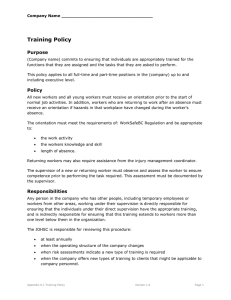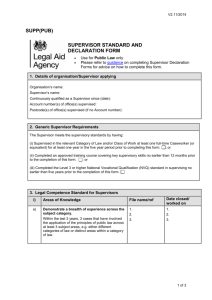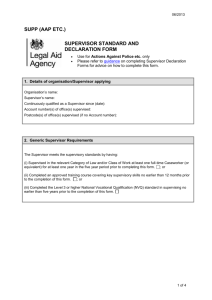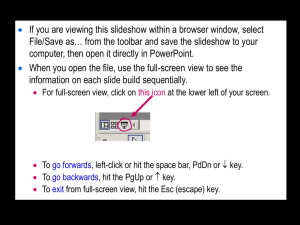IDENTIFYING ISSUES/BARRIERS GROUP ACTIVITY
advertisement
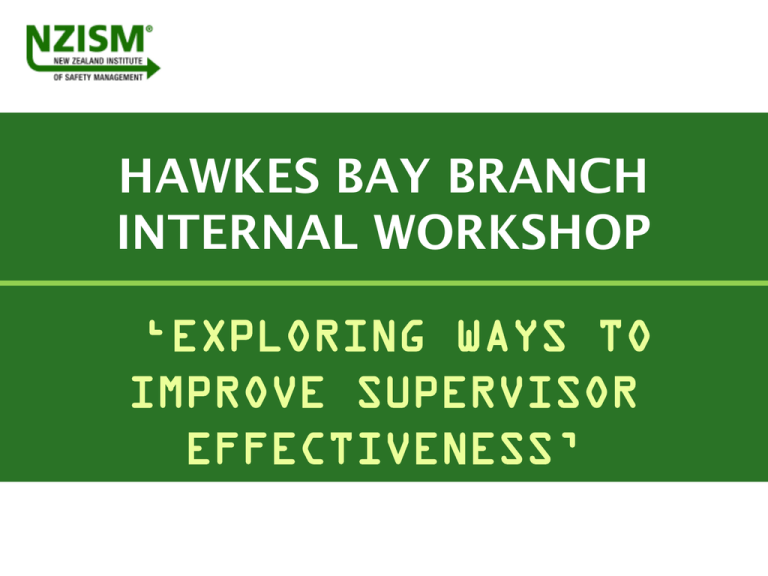
HAWKES BAY BRANCH INTERNAL WORKSHOP ‘EXPLORING WAYS TO IMPROVE SUPERVISOR EFFECTIVENESS’ CONTEXT FOR THE PRESENTATION Although a presentation was not used for the workshop it was agreed that a summary of the session in the form of a power point presentation might be a useful resource going forward. It could be used as a session outline and a record of the training or could be used as a foundation for individual presentations. The following should be noted: Slides include session notes and activity feedback from whiteboards Resources used in the session are attached as handouts The handouts used are from public websites except the supervisor self assessment There may be some caveats regarding the use of NZISM branding if re-using some or all of the slides TARGET = FRONT LINE SUPERVISORS WHY THIS FOCUS? Front line supervisors are a hugely influential group in an organisation who often are either: Under-estimated Under-utilised AND/OR Under-resourced PURPOSE OF THIS SESSION Refresh our awareness of the roles and influence of supervisors Identify what requirements are necessary to ensure effective supervision (skills, tools, support etc) Explore difficulties/barriers to putting these requirements in place Consider some actions going forward ** REMEMBER – The value of this workshop will be determined by the level of participation and sharing PART 1 THE IMPORTANCE OF EFFECTIVE SUPERVISION WHAT ROLES DO SUPERVISORS HAVE? GROUP ACTIVITY In groups of 2-3 Brainstorm various roles of supervisors Report back & List on Whiteboard (retain for use) Review and discuss Is there significant potential for impact on the business? ROLES OF SUPERVISORS GROUP ACTIVITY FEEDBACK LEADERSHIP MANAGER AWARENESS RECRUITMENT ACCOUNTABILITY DISCIPLINE PLANNING QUALITY CHECKER SOCIAL WORKER/MOTHER COMMUNICATOR MANAGING EXTERNAL CONTRACTORS INRTERMEDIARY PRODUCTIVITY TRAINER SAFETY WHAT AREAS OF THE BUSINESS COULD BE IMPACTED? The level and type of risk will vary with the types of business you operate. There are however some common categories which you can use to guide your thinking and the development of a risk management plan. Hand out the RISK CATEGORIES list (Appendix A) Consider which RISK CATEGORIES are likely to be impacted by supervisor roles Completing a formal risk assessment will help you establish the level of risk that poor performance of specific roles could present RISK ANALYSIS MATRIX CHART There are a number of Risk Management Matrix formats however they follow a similar structure. Review & discuss the Matrix and Rating chart (next Slide) RISK ANALYSIS MATRIX - RATING COMMON BUSINESS RISKS GROUP WORK ACTIVITY Form groups of 2 or 3 Hand out the Risk Matrix example (Appendix B) Each group pick a different ROLE from the whiteboard list to risk assess Complete a risk assessment for your selected role (i.e. the potential risk if that particular role was not performed Feedback results Any results significant? Any surprising results? Consider uses for this exercise: Engage management? Engage supervisors? WHAT NEXT? We’ve established how important and influential our supervisors can be but do we really know what’s required to undertake the role? Let’s explore the SKILL REQUIREMENTS. PART 2 REQUIREMENTS FOR EFFECTIVE SUPERVISION SKILLS & SUPPORT FOR EFFECTIVE SUPERVISION In order to perform the roles identified supervisors are going to require a range of: Relevant Skills Support and Resources Hand out and Review the Supervisory Skills Assessment form (Appendix C) Do you think it provides a good summary of the skills and support required for effective supervision? SKILLS & SUPPORT GROUP WORK ACTIVITY In groups of 2-3 Give each statement on the Supervisory Skills Assessment a score out of 10 for how important you think it is (10 is the top mark). Identify any 7’s, 8’s. 9’s and 10’s These are KEY REQUIREMENTS Group discussion on results Score your KEY REQUIREMENTS on how well they are done in your workplace (i.e. a second score out of 10) Any key requirement you’ve marked at least 2 points lower on how well it’s done is probably a priority WHAT NEXT? We’ve identified what’s required for effective supervision however there can be significant barriers to successful implementation. Let’s identify some of these BARRIERS. PART 3 BARRIERS TO EFFECTIVE SUPERVISION IDENTIFYING ISSUES/BARRIERS - TOOLS There are a number of tools available to identify underlying issues and barriers to ensuring appropriate skills, support and resources are in place in the workplace. These include: Fishbone analysis 5 Why method Gilberts Behaviour Engineering Model FISHBONE ANALYSIS The fishbone analysis is a popular problem solving tool used to identify underlying or root causes of a problem. Review use and discuss using attendees knowledge GILBERT’S BEHAVIOUR ENGINEERING MODEL By focusing on valuable accomplishments produced on the job by behaviour, Thomas F. Gilbert provided the missing link from individual or group behaviour to the economic goals of an enterprise. E M Environmental Supports Management P E Person’s Repertory 0f Behaviour Employee GILBERT’S BEHAVIOUR ENGINEERING MODEL Should be If SD & Sr are fixed by management Skills and Knowledge (needs to Motive/Attitude change) WHEN ALL CHANGED ALL GOOD IDENTIFYING ISSUES/BARRIERS GROUP ACTIVITY – FISHBONE ANALYSIS In 2’s/3’s – Each group is to select a specific KEY REQUIREMENT Handout the Fishbone Analysis worksheet (Appendix D) Complete a FISHBONE ANALYSIS for your KEY REQUIREMENT Your problem statement will start with “THE SUPERVISOR DOES NOT/IS NOT” Feedback results Summarise on the whiteboard BARRIERS GROUP ACTIVITY FEEDBACK Piecemeal Knowledge Management support Unclear expectations from management Job protection Attitude of Supervisor No orientation into role Culture Inability to create trust Lack of skills / confidence Profit/production driven Caught up in process ( unable to step back) Physical environment Unsuitable personality Awareness Personal skills Training Ability to manage team dynamics Lack of tools (forms, processes, motivators, acknowledgement) Cultural needs Gender differences WHAT NEXT? We’ve identified our effective supervisor requirements and some of the barriers to ensuring these are in place however now need to overcome barriers and ensure requirements are implemented Let’s explore some suggestions, strategies and resources to do this. PART 4 IMPLEMENTATION (SUGGESTIONS, RESOURCES, STRATEGIES) IMPLEMENTATION WHAT RESOURCES MIGHT BE OF USE? Suggestions from attendees: ACC Website E.G. Frontline Leadership MOE Website Sport NZ Other? IMPLEMENTATION POSSIBLE FOLLOW UP ACTIONS Suggestions from attendees: Produce workshop summary as a ppt presentation (JP & Michelle) Further workshop (Dan – IMPAC) Send further ideas to (Jo?) for collation and distribution (Everyone).

